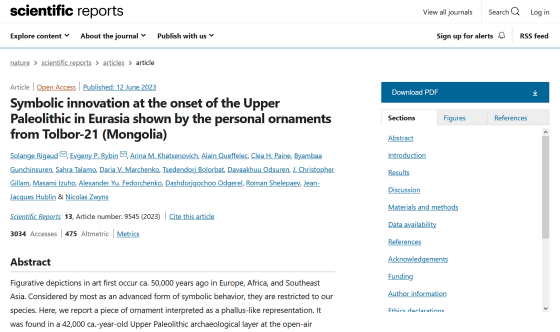Is it the world's oldest penis art work, where a ``penis pendant'' 42,000 years ago is discovered?

Modern people may feel radical when they hear 'a work of art with a motif of human genitals', but since ancient times, many sculptures and paintings with motifs such as penis have been created. A new research result that the object excavated at the excavation site 'Tolbor-21' in
Symbolic innovation at the onset of the Upper Paleolithic in Eurasia shown by the personal ornaments from Tolbor-21 (Mongolia) | Scientific Reports
https://doi.org/10.1038/s41598-023-36140-1

42,000-year-old Mongolian pendant may be earliest known phallic art | Science | AAAS
https://www.science.org/content/article/42-000-year-old-mongolian-pendant-may-be-earliest-known-phallic-art
42,000-year-old anatomically accurate penis pendant is the world's earliest known depiction of human genitalia | Live Science
https://www.livescience.com/archaeology/42000-year-old-anatomically-accurate-penis-pendant-is-the-worlds-earliest-known-depiction-of-human-genitalia
In 2016, Mongolian archaeologists discovered a small 4.3 cm long object at an excavation site called Tolbor-21 in the northern Khangai Mountains. The layer where this object was discovered is estimated to be 42,400 to 41,900 years old from radiometric dating of organic matter, and in addition to pendants, ornaments using ostrich eggshells and animal bone fragments etc. have also been discovered.
A research team led by Solange Rigaud, an archaeologist at the University of Bordeaux in France, has announced research results that this object, which is housed in the Mongolian Academy of Sciences, is a 'penis pendant'.
Looking at the pictures taken from the three directions of the object found in Tolbor-21 below, you can see that it certainly has a shape reminiscent of a penis.

``Our point is that when you want to express something abstractly, you extract the really concrete features that characterize what you want to express,'' said Rigaud. He claims to have paid attention to the shape of a certain urethral meatus and glans.

Surface examination, including microscopy, revealed that stone tools were likely used to create grooves for the urethra and glans, and that a string was likely fixed around the glans. . The research team believes that one side is particularly smooth and worn, which may have been the side that touched the body when hung from the neck.
Analysis using Raman spectroscopy also revealed that the pendant was made of graphite produced at a point about 100 km away from the discovery point. ``Graphite was a rare material and not commonly used in the area at the time,'' Rigaud said. I'm here.
According to the research team, this pendant is not only 'the world's oldest work of art with a penis motif', but also the vulva of Abri Castanet , France, which is estimated to be 37,000 years old. Without the mural painting, there is a possibility of ``the oldest expression with the motif of human genitalia''. It is unclear what the pendant was intended to be, but Rigaud said, ``Wearers use ornaments as a means of communicating their collective identity to others, or as objects that have personal meaning to them. I may have worn it,' he said.
Related Posts:
in Note, Posted by log1h_ik







